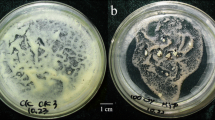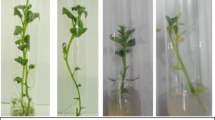Abstract
A system for in vitro selection of drought tolerant callus lines in sugarcane was developed. High molecular weight PEG was used as selective agent. Selected callus line grew better than non-selected callus when grown on different concentrations of PEG. The activity of antioxidant enzymes like CAT, POX, APX and SOD were high in selected callus than in non-selected callus. Osmolytes like proline and ascorbic acid were at higher levels in selected callus than in non-selected callus, however at higher concentrations (20–30 %) of PEG, levels of proline and ascorbic acid decreased. The frequency of organogenesis and number of plantlets decreased in selected callus than in non-selected callus. The results can be used for in vitro screening and manipulations of sugarcane for improvement of drought tolerance


Similar content being viewed by others
Abbreviations
- 2,4-D:
-
2,4-dichloro phenoxy acitic acid
- BAP:
-
6-Benzyl aminopurin
- NAA:
-
α-Napthalene acitic acid
- Kn:
-
Kinetin
- CAT:
-
Catalase
- POX:
-
Peroxidase
- APX:
-
Ascorbate peroxidase
- SOD:
-
Superoxide dismutase
- MS:
-
Murashige and Skoog
- ROS:
-
Reactive Oxygen Species
References
Aazami MA, Torabi M, Jalili E (2010) In vitro response of promising tomato genotypes for tolerance to osmotic stress. Afr J Biotechnol 9(26):4014–4017
Abdel-Raheem AT, Ragab AR, Kasem ZA, Omar FD, Samera AM (2007) In vitro selection for tomato plants for drought tolerance via callus culture under polyethylene glycol (PEG) and mannitol treatments. Afr Crop Sci Conf Proc 8:2027–2032
Aqeel-Ahmad MS, Javed F, Ashraf M (2007) Iso-osmotic effect of NaCl and PEG on growth, cations and free proline accumulation in callus tissue of two indica rice (Oryza sativa L.) genotypes. Plant Growth Regul 53:53–63
Bates LS, Waldren RP, Teare ID (1973) Rapid determination of free proline for water stress studies. Plant Soil 39:205–207
Begum MK, Islam MO, Miah MAS, Hossain MA, Islam N (2011) Production of Somaclone In vitro for Drought Stress Tolerant Plantlet Selection in Sugarcane (Saccharum officinarum L.). Agriculturists 9(1&2):18–28
Beyer WF, Fridovich I (1987) Assaying for superoxide dismutase activity: some large consequences of minor changes in condition. Annal Biochem 161:559–566
Bhaskaran S, Smith RH, Newton RJ (1985) Physiological changes in cultured Sorgham cells in response to induced water stress 1. Free proline. Plant Physiol 79:239–248
Bradford MM (1976) A rapid and sensitive method for the quantitation of micro gram quantities of protein utilizing the principle of protein–dye binding. Anal Biochem 72:248–254
Bueno P, Piqueras A, Kurepa J, Savoure A, Veerbruggen N, Montegu MV, Inze D (1998) Expression of antioxidant enzymes in response to abscisic acid and high osmoticum in BY-2 cell cultures. Plant Sci 138(1):27–34
Chandlee JM, Scandalios JG (1984) Analysis of variants affecting the catalase development program in maiz scutellum Theor. Appl Genetics 69:71–77
Davies KJA (1987) Protein damage and degradation by oxygen radicals. J Biol Chem 262:9895–9901
El-Haris MK, Barakat MN (1998) Evaluation of the in vitro selected drought tolerant wheat lines under drought stress conditions. Alex J Agric Res 43:293–302
Errabii T, Gandonou CB, Essalmani H, Abrini J, Idaomar M, Senhaji NS (2006) Effects of NaCl and mannitol induced stress on sugarcane (Saccharum sp.) callus cultures. Acta Physiol Plant 29:95–102
Errabii T, Gandonou CB, Essalmani H, Abrini J, Idaomar M, Senhaji NS (2008) Growth, proline and ion accumulation in sugarcane callus cultures under drought-induced osmotic stress and its subsequent relief. Afri J Biotechnol 5:1488–1493
Fridovich I (1986) Biological effects of superoxide radical. Arch Biochem Biophys 247:1–11
Gangopadhyay G, Basu S, Mukherjee BB, Gupta S (1997) Effect of salt and osmotic shocks on unadapted and adapted callus lines of tobacco. Plant Cell Tiss Org Cult 49:45–52
Handa S, Handa AK, Hasegawa PM, Bressan RA (1986) Proline accumulation and the adaptation of cultured plant cells to water stress. Plant Physiol 80:938–945
Hassan NS, Shaaban LD, El-Sayed AH, Seleem EE (2004) In Vitro Selection for Water Stress Tolerant Callus Line of Helianthus annus L Cv Myak. Int J Agric Biol http://www.ijab.org
Heath RL, Packer (1968) Photooxidation in isolated chloroplasts. Arch Biochem Biophys 125:189–198
Jabeen FTZ (2007) Selection of drought tolerant cell lines in sugsrcane (Saccharum offcinarum Linn.) through cell and tissue culture technique. PhD. Thesis submitted to Gulbarga University Gulbarga Karnataka India
Jadhav YR, Garkar RM, Najan BR, Khade KK, Choudhary AN (1998) Nira (Co-86032) A new variety of sugarcane of Maharastra. J Maharastra agricuniv 23(1):10–12
Kumar KB, Khan PA (1982) Peroxidase and Polyphenol oxidase in excised ragi (Elaucine coracona cv. 2020 leaves during senescence Indian. Expt Bot 20:412–416
Kumar RR, Karjol K, Naik GR (2011) Effect of polyethylene glycol induced water stress on physiological and biochemical responses in Pigeon pea (Cajanus cajan L. Millsp.). RRST-Plant Physiol 3:148–152
Larson RA (1988) The antioxidants of higher plants. Phytochemistry 27:969–978
Li L, van Stadan J (1998) Effects of plant growth regulators on the antioxidant systems in callus of two maiz cultivars subjected to water stress. Plant Growth Regul 24:55–66
Ming SY, ZhiDong Z, YaDong L, Wu L, Liu HG (2009) Effect of PEG stress on resistance of low bush blueberry callus. J Jilan Agric Univ 31(5):538–542
Murashige T, Skoog F (1962) A revised medium for rapid growth and bioassay with tobacco tissue culture. Physiol Plant 15:473–497
Musa Y (2011) The use of Polyethylene glycol (PEG) as selection agent of callus and plantlets of some sugarcane varieties for drought tolerance. J Agrivigor 10(2):130–140
Nakano Y, Asada K (1981) Hydrogen peroxide is scavenged by ascorbatespecific peroxidase in spinach chloroplast. Plant Cell Physiol 22:867–880
Nath AK, Kumari S, Sharma DR (2005) In Vitro selection and chaterization of water stress tolerant cultures of bell pepper. Indian J Plant Physiol 10(1):14–19
Patade VY, Bhargava S, Suprasanna P (2011) Salt and drought tolerance of sugarcane under iso-osmotic salt and water stress: growth osmolyte accumulation and antioxidant defense. J plant interact 6(4):275–282
Patade VY, Bhargava S, Suprasanna P (2012) Effects of NaCl and iso-osmotic PEG stress on growth, Osmolytes accumulation and antioxidant defense in cultured sugarcane cells. Plant Cell Tissue Organ Cult 108:279–286
Prabha C, Bharti S (1980) Effect of ascorbic acid on proline accumulation in cowpea leaves under water stress conditions. Indian J Plant Physiol 23:317–318
Sabbah S, Tal M (1990) Development of callus and suspension cultures of potato resistant to NaCl and mannitol and their response to stress. Plant Cell Tissue Organ Cult 21:119–124
Sadasivam S, Manickam A (1992) Biochemical methods for agricultural sciences, vol 80. Wiley Eastern Limited, New Delhi, pp 179–180
Santos-Diaz N, Ochoa-Alejo N (1994) Effect of water stress on growth, osmotic potential and solute accumulation in cell cultures from chilli pepper (a mesophyte) and Creosote bush (a xerophytes). Plant Sci 96(1–2):21–29
Shah AH, Shah SH, Ahmad H, Swati ZA (2012) Adaptation to polyethylene stress maintains totipotency of cell lines of Oryza sativa L. CV Swat-1 for a longer period. Pak J Bot 44(1):313–316
Siddeswar G, Kavi Kishor PB (1989) Plant regeneration from polyethylene glycol adapted callus of rice. Curr Sci 58:926–928
Singh AK, Sharma DR (2008) In vitro screening and regeneration of water stress tolerant culture of tomato. Indian J Plant Physiol 13(1):33–38
Srivastava DK, Gupta VK, Sharma DR (1995) In vitro selection and characterization of water stress tolerant callus cultures of tomato (Lycopersicon esculentum L. Mill cv. Ktl.). Indian J Plant Physiol 38:99–104
Yaser F, Uzal O, Ozpay T (2010) Changes of lipidperoxidation andchlorophyll amount of greenbean genotypes underdrought stress. Afr J Agric Res 5(19):2705–2709
Acknowledgements
The authors thank head department of Botany Gulbarga University Gulbarga for the facilities provided during the course of the investigation,
Author information
Authors and Affiliations
Corresponding author
Rights and permissions
About this article
Cite this article
Rao, S., FTZ, J. In vitro selection and characterization of polyethylene glycol (PEG) tolerant callus lines and regeneration of plantlets from the selected callus lines in sugarcane (Saccharum officinarum L.). Physiol Mol Biol Plants 19, 261–268 (2013). https://doi.org/10.1007/s12298-013-0162-x
Published:
Issue Date:
DOI: https://doi.org/10.1007/s12298-013-0162-x




